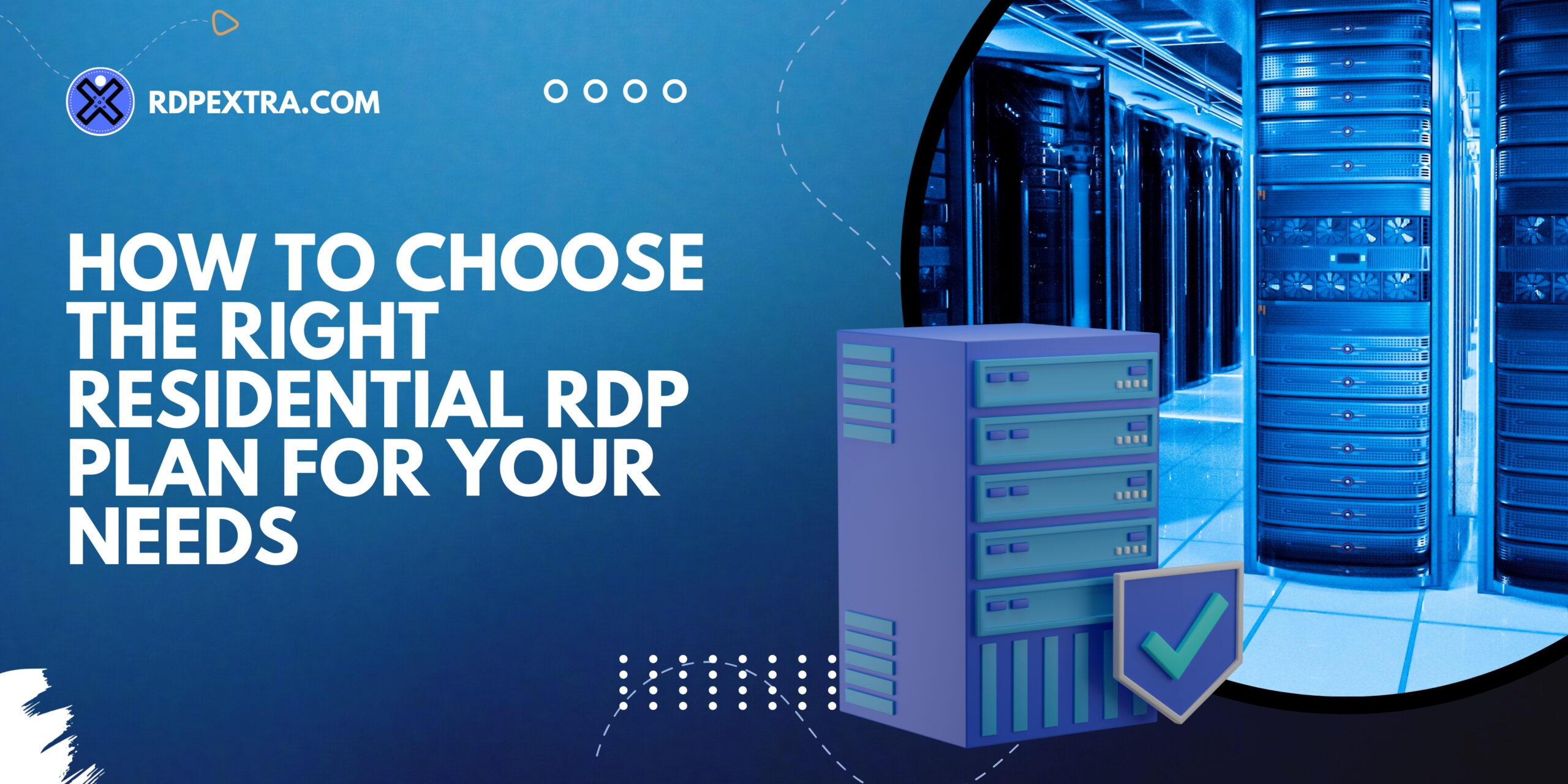
Choose the Right Residential RDP Plan — 7-Step Guide
Introduction — stop guessing, start choosing
Imagine you’re trying to test an ad that only shows in New York, or you need a stable remote Windows desktop that looks like a local home user to websites. You search “buy residential RDP” and drown in plan pages, IP options, and fine print. Sound familiar? Residential RDP Buy residential RDP.
Residential RDPs (RDP with residential IP) are powerful — but only when you pick the right plan for your needs. Pick wrong and you waste money, face blocks, or end up with a slow, unreliable setup. Pick right and you get stealthy access, better geo-targeting, and a reliable remote workflow.
TL;DR: Use the 7-step decision framework below to match your exact use case to the correct residential RDP plan. Read the checklist at the end and download it to speed up decisions.
What is Residential RDP — and why does the IP type matter?
Residential RDP = a Remote Desktop (usually Windows) where the server’s external IP is RDP with a residential IP (assigned by an ISP to a home). That IP behaves like a normal end-user address — less likely to be flagged compared to datacenter IPs.
Key differences:
- Residential IPs look like home users → lower block rates on many websites.
- Datacenter IPs are hosted in cloud providers → often higher block/verification rates.
- Sticky (static) vs rotating IPs: Sticky keeps the same residential IP; rotating regularly switches IPs from a pool. Each has use cases.
When to prefer residential IPs: localized testing, web scraping where block risk is high, ad verification, and social account management.
7-step decision framework — pick the right residential RDP plan
Use this as a mental checklist. I’ll show the reasoning for each step and what trade-offs you accept.
Step 1 — Define your primary use case (the north star)
Why you need Residential RDP determines everything:
- Scraping → prioritize rotating IPs, high bandwidth, and concurrency controls.
- Ad verification / geo-testing → need geo-targeted, stable (sticky) residential IPs in exact cities/states.
- Remote work/desktop access → focus on CPU/RAM, storage, persistent desktop, and OS licensing.
- Account management → stable IP per account (sticky), strong security, and multi-factor auth.
Reasoning: The use case tells you whether to favor rotation (avoid blocks) or persistence (avoid suspicious login patterns).
Step 2 — Determine technical specs you actually need
Don’t buy the biggest plan just because it’s flashy. Match specs to tasks.
Important specs:
- Concurrency / Sessions — how many simultaneous RDP sessions you’ll run.
- CPU & RAM — heavier browser automation or parallel Chrome instances need more CPU and RAM.
- Bandwidth & Transfer — scraping images, media, or heavy browsing needs higher bandwidth.
- Storage — small for simple tasks, larger for caching, logs, or installed apps.
- OS & GPU — some providers offer GPU-backed Windows desktops for visual tasks.
Example: For light scraping and rank checking: 2–4 CPU cores, 4–8GB RAM, moderate bandwidth. RDP with residential IP for heavy automation with multiple headless browsers: 8+ cores, 16GB+ RAM.
Step 3 — Decide IP behavior: sticky, rotating, or geo-specific
- Sticky residential IPs: best for account-bound workflows and remote desktop consistency.
- Rotating residential IPs: best for large-scale scraping to reduce blocking risk.
- Geo-specific pools: required if you must appear from a particular city or region.
Trade-offs: Rotating helps anonymity but can break sessions. Sticky supports persistent logins but may get flagged if reused heavily.
Step 4 — Security, authentication, and compliance
Check:
- Authentication methods: password + 2FA (if supported), key-based options, VPN tunneling.
- Access logs & IP audit: useful for compliance and troubleshooting.
- Provider policies & acceptable use: ensure your intended tasks are permitted.
- Encryption & endpoint security: Windows updates, antivirus, or provider-managed security options.
Red flag: A provider that avoids logging or won’t share policy details.
Step 5 — Support, SLA & trial testing
- Trial period: Always test — a short trial or money-back guarantee is essential.
- Support channels: Live chat, ticketing, and technical help — crucial if you hit blocks or latency issues.
- SLA / uptime: Look for clear uptime commitments if you rely on the desktop for business tasks.
Pro tip: Test during business hours in the target geography to measure real-world latency and block rates.
Step 6 — Pricing model & payment options
Understand pricing structure:
- Flat monthly vs hourly: choose depending on usage predictability.
- Bandwidth caps & overage fees: hidden costs can add up.
- Payment options: credit, PayPal, crypto, or invoices — choose what fits your company policy.
Budgeting tip: RDP with residential IP. Start small to validate and then scale. Don’t lock into a large annual plan until you’ve tested.
Step 7 — Scale, monitor & refine (Self-Refinement)
Buying isn’t the end. Iteratively refine:
- Monitor success metrics: latency, block rate, and task completion.
- Adjust plan: more CPU, switch from rotating to sticky IP, or add geo-targeted IPs.
- Automate health checks: simple scripts to verify uptime and IP identity.
Why this matters: Conditions change—websites update mitigation—so keep iterating.
How to evaluate providers — the “Best Residential RDP Provider” checklist
Rather than a single “RDP with residential IP” provider, look for a provider that’s the best fit for your use case. Score them on:
- IP Quality & Origin
- Can they supply true residential IPs from the required country/city?
- Can they supply true residential IPs from the required country/city?
- IP Behavior Options
- Sticky vs rotating? Pool size? Rotation interval?
- Sticky vs rotating? Pool size? Rotation interval?
- Performance
- CPU/RAM options, bandwidth caps, and measured latency to target locations.
- CPU/RAM options, bandwidth caps, and measured latency to target locations.
- Testing & Refunds
- Trial, money-back, or credit for unsatisfactory service.
- Trial, money-back, or credit for unsatisfactory service.
- Support & Documentation
- Clear setup guides, API docs, and responsive support.
- Clear setup guides, API docs, and responsive support.
- Security & Compliance
- Logs, encryption, AUP clarity, and data handling policies.
- Logs, encryption, AUP clarity, and data handling policies.
- Pricing Transparency
- No hidden fees for bandwidth or additional sessions.
- No hidden fees for bandwidth or additional sessions.
- Ease of Use
- Dashboard, API, credential management, and integration options.
- Dashboard, API, credential management, and integration options.
Scoring Tip: Give each category 1–10 and rank providers based on total score — more objective than hype.
Common mistakes — avoid these traps
- Buying for features, not use-cases. (E.g., choosing rotating IPs when you need sticky.)
- Ignoring bandwidth and overage fees.
- Skipping a trial or not stress-testing during real usage times.
- Choosing providers without clear acceptable-use policies.
- Overlooking support responsiveness — when RDP fails, you need fast help.
Quick red flags: Extremely cheap plans with unlimited claims and no transparency. Lack of trial/refund.
Mini case studies — which plan suits which scenario
A — Small agency doing localized ad checks
- Need: Geo-specific, stable residential IPs in 4 cities; 2 concurrent sessions.
- Choose: Sticky residential RDPs per city, moderate CPU/RAM, trial for each location.
B — Large-scale price scraping
- Need: High concurrency, rotating IPs, and large bandwidth.
- Choose: Rotating residential IP pool, more CPU cores, scalable hourly pricing, and strict rate-limiting to be ethical.
C — Remote worker who needs a home IP for a SaaS tool
- Need: Single persistent desktop, Windows, reliable support.
- Choose: Sticky residential RDP with 4–8GB RAM, clear backup/restore options.
Conclusion
Choosing the right residential RDP plan comes down to a clear, repeatable decision process: define your use case → match specs → test → scale. There’s no universal “best residential RDP provider” — only the best match for your needs.
Ready to make a confident purchase?
Download our free 1-page Residential RDP Checklist (compact, printable) — it turns the 7-step framework into simple yes/no boxes so you can compare providers in 10 minutes. [Invite readers to download our checklist — place link/button here on your site]
FAQ
A: Yes — when used ethically and within provider terms and local law. Avoid misuse like account fraud, spam, or unauthorized access.
A: Yes — use sticky IPs per account and follow platform rules to avoid bans.
A: No — they reflect ISP-assigned addresses and can be traced; anonymity isn’t guaranteed.
A: Reliability first if it’s for business-critical tasks; price matters more for experimental or low-risk tasks.

Leave a Reply